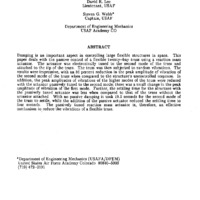-
Title
-
Passive Control of a Flexible Planar Truss Using a Reaction Mass Actuator
-
Description
-
Damping is an important aspect in controlling large flexible structures in space. This paper deals with the passive control of a flexible twenty-bay truss using a reaction mass actuator. The actuator was electronically tuned to the second mode of the truss and attached to the tip of the truss. The truss was then subjected to random vibrations. The results were impressive, with an 86 percent reduction in the peak amplitude of vibration of, the second mode of the truss when compared to the structure's uncontrolled response. In addition, the peak amplitudes of vibrations of the higher modes of the truss were reduced with the actuator passively tuned to the second mode; there was a small change in the peak amplitude of vibration of the first mode. Further, the settling time for the structure with the passively tuned actuator was less when compared to that of the truss without the actuator attached. With no passive damping it took 19.5 seconds for the second mode of the truss to settle, while the addition of the passive actuator reduced the settling time to four seconds. The passively tuned reaction mass actuator is, therefore, an effective mechanism to reduce the vibrations of a flexible truss.
-
Creator
-
Lee, David R.
-
Webb, Steven G.
-
Publisher
-
Wright-Patterson Air Force Base, OH : Wright Laboratory, Flight Dynamics Directorate, Air Force Systems Command
-
Date
-
1991
-
Format
-
1 online resource (16 pages) : ill.
-
Type
-
article
-
Abstract
-
Damping is an important aspect in controlling large flexible structures in space. This paper deals with the passive control of a flexible twenty-bay truss using a reaction mass actuator. The actuator was electronically tuned to the second mode of the truss and attached to the tip of the truss. The truss was then subjected to random vibrations. The results were impressive, with an 86 percent reduction in the peak amplitude of vibration of, the second mode of the truss when compared to the structure's uncontrolled response. In addition, the peak amplitudes of vibrations of the higher modes of the truss were reduced with the actuator passively tuned to the second mode; there was a small change in the peak amplitude of vibration of the first mode. Further, the settling time for the structure with the passively tuned actuator was less when compared to that of the truss without the actuator attached. With no passive damping it took 19.5 seconds for the second mode of the truss to settle, while the addition of the passive actuator reduced the settling time to four seconds. The passively tuned reaction mass actuator is, therefore, an effective mechanism to reduce the vibrations of a flexible truss.
-
Date Issued
-
1991-08
-
Extent
-
16
-
Corporate Author
-
USAF Academy
-
Laboratory
-
Wright Laboratory
-
Report Number
-
WL-TR-91-3078 Volume II, pages GBC-1 to GBC-16
-
DoD Project
-
2401
-
DoD Task
-
240104
-
Distribution Conflict
-
No
-
Index Abstract
-
Contrails only
-
Photo Quality
-
Complete
-
Distribution Classification
-
1
-
Report Availability
-
Full text available
-
Provenance
-
University of Colorado Colorado Springs, Kraemer Family Library
-
Identifier
-
ADA241312
